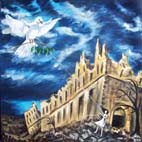Visitors to Cassino can see a collection of 30 Legato works in the Expo area of the Banca Popolare del Cassinate, in Corso della Repubblica, Cassino.
These works include new works by Robyn Hughes, New Zealand, and works by Cassino resident, Julia Udoratina from Russia.
Robyn uses layered images to explore and represent aspects of the battles of Cassino.
Julia's works challenge the concept that the world is a better place now, suggesting that the world is still in a mess, and has not gone forward from the chaos and tragedy of wartime at all.
Well recognised works by Merv Appleton remind us about the loss of life in wartime, but also suggest that life can go on with hope for a better future.
Regan Balzer references the Maori battalion in her three paintings which were first shown in Italy in 2011.
Kay de Lautour focuses on the civilians, both then and now, and an interesting work by Susan Edge from the 2010 exhibition asks us to think about the pull that we all face when family and community members are away at war.
Other artists included are Daniele Corsi, Ira Mitchell, Sarah Scott, Stan Blanch, Linda Dickens, Bernadette McCormack, Gail Boyle and Nancy Stevens.
New works by featured artist for 2013 Professor Alessandro Nardone, Cassino resident Dr Danilo Salvucci and New Zealander Geoff Tune will be on display in the main venue, the Sala Restagno in the Comune building, from Saturday morning at 9.30am, along with works by Anna Maria Corsi, Sara Antonini and Kay de Lautour.























